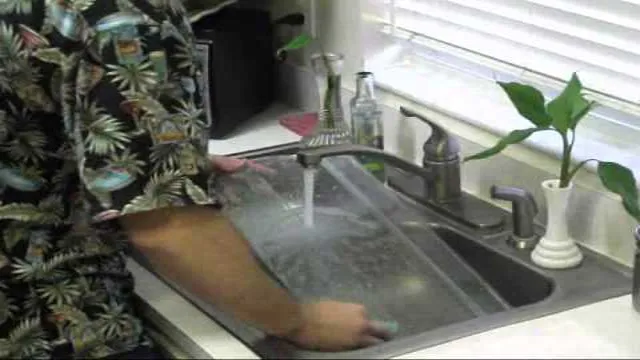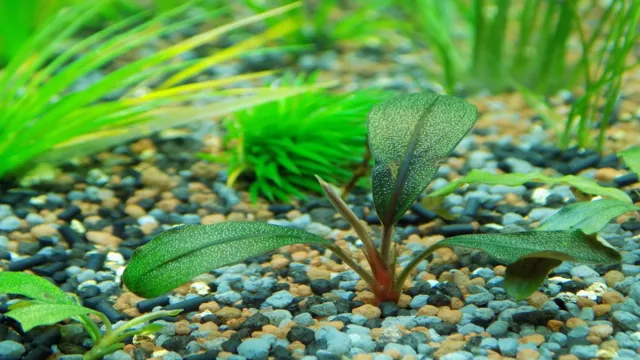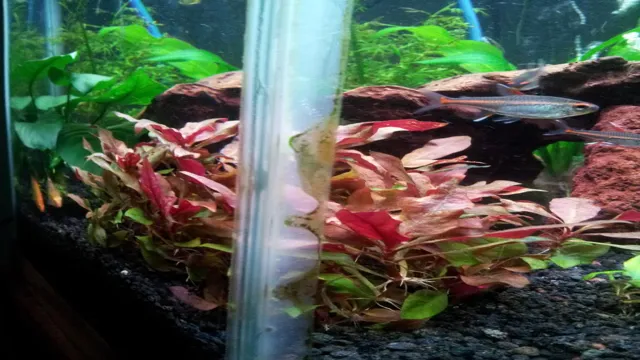An aquarium is not just a home for your aquatic pets but also a decorative piece for your living space. However, maintaining its cleanliness can be a daunting task, particularly if you are a pet parent for the first time. One of the essential parts of an aquarium is the plastic hood that prevents debris and dust from settling on the water surface.
A dirty hood can restrict the light from penetrating the water and disrupt the natural ecosystem of your aquatic pets. Therefore, it is crucial to regularly clean your plastic aquarium hood to maintain optimal living conditions for your finned friends. In this blog, we will guide you on how to effectively clean your plastic aquarium hood to keep both your pets happy and your living space shining.
Gather Supplies
When it comes to cleaning your plastic aquarium hood, the first step is to gather all the necessary supplies. You’ll want to have a soft-bristled brush, such as a toothbrush or a vegetable brush, as well as a bucket, warm water, and dish soap. If your hood has stubborn stains or algae buildup, you may also want to invest in an aquarium-safe cleaner.
It’s important to only use products that are specifically designed for aquariums, as household cleaners can be toxic to your aquatic pets. Additionally, avoid using rough or abrasive materials that can scratch or damage the plastic surface of your hood. Once you have everything you need, it’s time to roll up your sleeves and get to work tackling that grime!
What You Will Need
When it comes to starting any project, gathering the necessary supplies should always be your first step. When starting a new craft or DIY project, there are a few key supplies that you should have on hand to ensure that you’re able to complete your project successfully. First and foremost, you’ll need your chosen crafting materials.
These can vary wildly depending on your chosen project, whether it’s yarn and needles for knitting, paints and brushes for painting, or fabric and a sewing machine for sewing. Beyond your primary materials, you’ll also need a few basic tools, such as scissors, measuring tools, and adhesive. It’s always a good idea to invest in high-quality tools, as they’ll help you create a better end result with less frustration.
Finally, a clean workspace and comfortable area to work in are important for both your physical and mental well-being. Making sure that you have all of these supplies on hand before you dive into your next project will help ensure that you have a smooth and stress-free crafting experience.

Safety Precautions to Take
When it comes to safety precautions, one of the most critical steps you can take is gathering supplies. This means having all the necessary tools and equipment on hand to prevent accidents and respond to emergencies. Depending on the situation, your supplies may include personal protective gear such as gloves and goggles, fire extinguishers, first aid kits, and emergency communication devices.
It’s also essential to make sure that your supplies are in good condition and easily accessible. This means checking expiration dates, replacing worn-out items, and organizing your equipment in a designated area. By taking the time to gather supplies, you can help ensure that you’re prepared for the unexpected and able to respond quickly and effectively in case of an emergency.
So, always be sure to keep your supplies current and ready for action!
Steps for Cleaning
Cleaning your plastic aquarium hood is essential to maintain a healthy and safe environment for your fish. The first step is to unplug any electrical equipment from the hood. Then, remove any decorations or plants attached to the hood.
Next, use a soft cloth or sponge dipped in warm, soapy water to wipe the entire surface of the hood, inside and out. Make sure to get into any crevices or corners to remove any debris or algae buildup. For tougher stains, use a vinegar solution or a specialized aquarium cleaner.
Rinse the hood thoroughly with clean water, making sure there is no soap or cleaner left behind. Finally, dry the hood with a clean, soft cloth before plugging it back in and reattaching any decorations or plants. By following these simple steps, you can keep your plastic aquarium hood in tip-top shape and create a healthy environment for your aquatic pets. (See Also: How To Keep Your Aquarium Crystal Clear: Tips and Tricks for Clear Water)
Step One: Unplug and Remove the Hood
When it comes to cleaning your kitchen, one of the most overlooked areas is the hood above the oven. But with the buildup of grease and grime, it’s important to give it a thorough cleaning every so often. The first step in this process is to unplug and remove the hood from above the stove.
This may seem like a hassle, but it’s necessary to ensure a proper cleaning. Start by flipping the breaker switch to turn off power to the hood, and then carefully remove any screws or bolts holding it in place. Grab a friend to help you with this step to avoid any accidents or damage.
Once the hood is removed, it’s time to move on to the next steps for a squeaky clean hood and kitchen. With a little bit of elbow grease and the right techniques, you’ll have a sparkling clean kitchen in no time.
Step Two: Clean the Exterior
When it comes to cleaning the exterior of your home, there are a few important steps you should follow to ensure that you get the job done right. Step two of the cleaning process involves cleaning the exterior of your home. This step is important to remove any dirt, grime, or other debris that may have accumulated on the surface of your home.
A good place to start is by using a power washer to remove any loose dirt and debris. Be sure to pay extra attention to any areas that may be particularly dirty or stained. After you have finished using the power washer, you can then use a cleaning solution and a soft-bristled brush to remove any remaining dirt or grime.
Be sure to rinse the surface thoroughly with water to remove any remaining soap residue. By following these steps, you can ensure that the exterior of your home is clean and free from any unsightly stains or debris. The keyword used in this paragraph is “cleaning.
“
Step Three: Clean the Interior
Now that the exterior of your car is spotless, it’s time to move inside for the most detailed clean. The first step in cleaning the interior is to remove any clutter or trash lying around. It’s essential to get rid of any objects that may get in the way of thorough cleaning.
Once the clutter is gone, use a vacuum cleaner to clear all the dirt, dust, and debris from the floor carpets, seats, and dashboard. Use a soft-bristled brush attachment to guarantee that you do not damage the upholstery. If your car’s interior is plastic, use a damp microfiber cloth to wipe it down gently.
Avoid using harsh chemicals on any interior surfaces as they may cause permanent damage. Ensure that the hard-to-reach spaces, such as air vents, are also cleaned out. Performing the internal clean will not only help improve the look of your vehicle but also make it more comfortable to drive, particularly if you suffer from allergies.
So, take the time to deep clean your car’s interior and give it the renewed feel it deserves. (See Also: How to Add Garlic to Aquarium to Improve Fish Health and Immunity: A Comprehensive Guide)
Step Four: Dry and Reattach the Hood
After rinsing off the hood of your car and applying a cleaning solution, the next step is to dry it thoroughly before reattaching it. Start by using a microfiber towel to wipe away any remaining solution from the hood, being sure to get into all the corners and edges. Next, use a chamois or another absorbent towel to dry the surface completely.
Make sure there are no streaks or drips left behind. Once the hood is dry, it’s time to reattach it to the car. Follow the manufacturer’s instructions to ensure a proper fit.
It’s important to make sure the hood is securely in place to prevent any accidents while driving. With these steps, you can have a clean and safe car hood.
Additional Tips and Warnings
When it comes to cleaning plastic aquarium hoods, there are a few additional tips and warnings to keep in mind. Firstly, be careful not to scratch the surface of the plastic with any rough tools or brushes. This can cause damage or make it easier for algae and other debris to accumulate.
Instead, use a soft cloth or sponge to gently wipe away any dirt or grime. Secondly, always rinse the hood thoroughly after cleaning to avoid any soap residue or cleaning solution getting into the tank and harming your fish or plants. Additionally, if you are using any type of aquarium-safe cleaner, make sure to follow the instructions closely and only use as directed.
Finally, if you notice any cracks or damage to the hood, it may be time to replace it to ensure the safety of your aquatic pets. By following these tips and precautions, you can keep your plastic aquarium hood looking clean and clear for optimal viewing pleasure.
Final Thoughts
Final Thoughts As a final note, here are some additional tips and warnings that you should keep in mind when it comes to on-page SEO. First and foremost, make sure that you’re creating content that is both helpful and engaging for your readers. Don’t just stuff your pages with keywords and call it a day; instead, aim to provide answers to your audience’s most pressing questions.
Additionally, be sure to optimize your URLs, title tags, and meta descriptions for each page on your website, as these elements play a vital role in how search engines interpret and rank your content. Finally, steer clear of any black hat SEO practices, such as keyword stuffing, cloaking, and link schemes, as these tactics will only hurt your site’s reputation in the long run. With these tips in mind, you’ll be well on your way to creating an on-page SEO strategy that drives traffic and boosts conversions.
Warnings and Safety Tips
When it comes to safety, there are a few extra tips and warnings to keep in mind. Firstly, always be aware of your surroundings and be cautious of people or situations that may seem suspicious. It’s important to trust your instincts and remove yourself from any potential danger.
Additionally, if you’re traveling, research your destination beforehand to familiarize yourself with the area and any potential risks. Make sure to keep your personal belongings secure and consider using a money belt to keep your valuables safe. When out and about, avoid flashing your cash or expensive items to avoid becoming a target for theft.
Lastly, be mindful of your alcohol intake and avoid drinking excessively, which can impair your judgment and leave you vulnerable to dangerous situations. By keeping these tips in mind, you can ensure your safety and enjoy your travels with peace of mind.
Conclusion
In conclusion, cleaning a plastic aquarium hood doesn’t have to be fishy business. With a little bit of elbow grease and some simple household items, you can have your hood looking crystal clear in no time. So next time you’re staring into your aquarium and notice a fuzzy film coating your hood, don’t be shellfish with the cleaning duties – dive right in and get it done! Your aquatic friends will thank you for it. (See Also: How to Hide Internal Aquarium Filter: 6 Simple Ways to Keep Your Tank Clean and Visually Appealing)
“
FAQs
What is the best way to clean a plastic aquarium hood?
The best method to clean a plastic aquarium hood is to use a non-abrasive cleaner such as vinegar and water. Simply mix equal parts vinegar and water and wipe down the hood with a soft cloth.
Can I use bleach to clean my plastic aquarium hood?
No, using bleach to clean a plastic aquarium hood is not recommended as it can damage the plastic and harm aquatic life. Stick to non-abrasive cleaners like vinegar and water.
How often should I clean my plastic aquarium hood?
It is recommended to clean your plastic aquarium hood once a month to keep it free of algae and other debris. However, if your aquarium gets dirty quickly, more frequent cleanings may be necessary.
Can I use soap to clean my plastic aquarium hood?
Only use a mild soap, such as dish soap, to clean your plastic aquarium hood. Be sure to rinse thoroughly to avoid any residue that could be harmful to your aquatic life.
I have hard water stains on my plastic aquarium hood. How do I remove them?
Hard water stains can be removed from a plastic aquarium hood by using a mixture of vinegar and baking soda. Mix the two together to form a paste, apply it to the stains, and let it sit for 15 minutes before wiping it away with a soft cloth.
Is it okay to use a scrub brush to clean my plastic aquarium hood?
No, using a scrub brush on a plastic aquarium hood can cause scratches and damage the plastic. Stick to using a soft cloth or sponge to clean your hood.
What should I avoid using to clean my plastic aquarium hood?
Avoid using abrasive cleaners, bleach, or any product that contains ammonia as it can harm aquatic life and damage the plastic. Stick to non-abrasive cleaners like vinegar and water.







